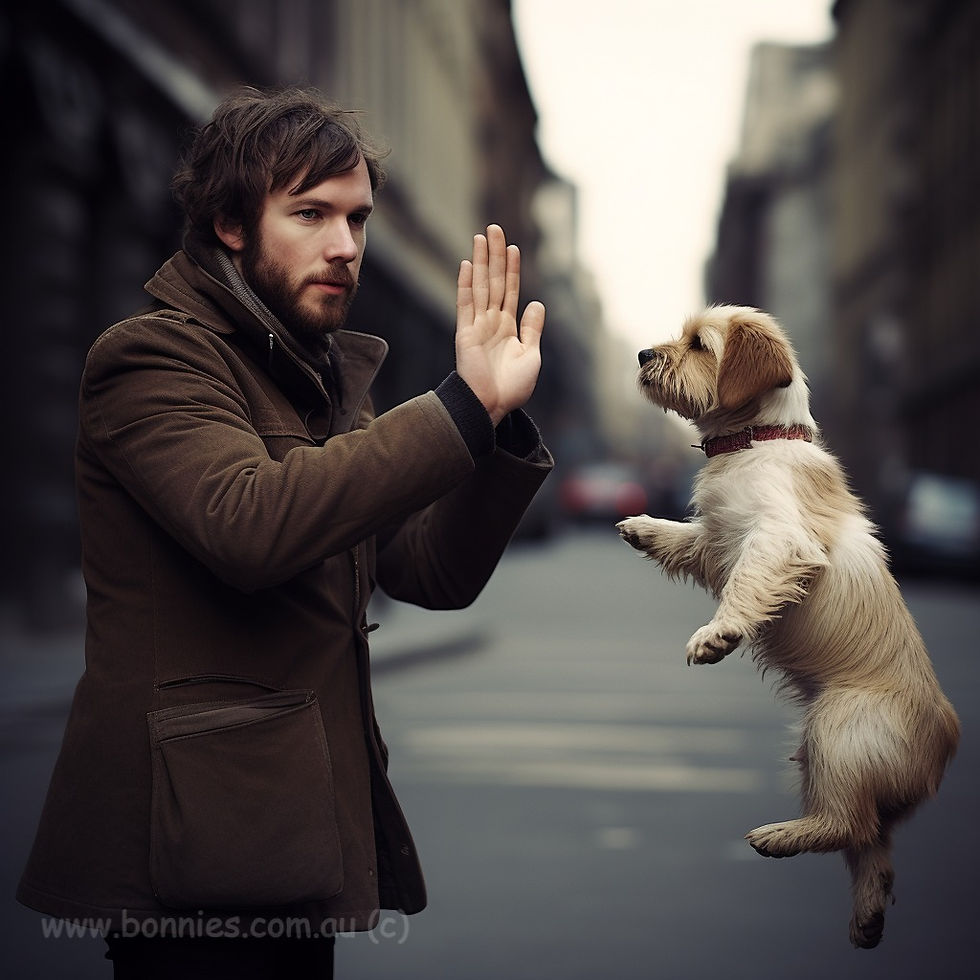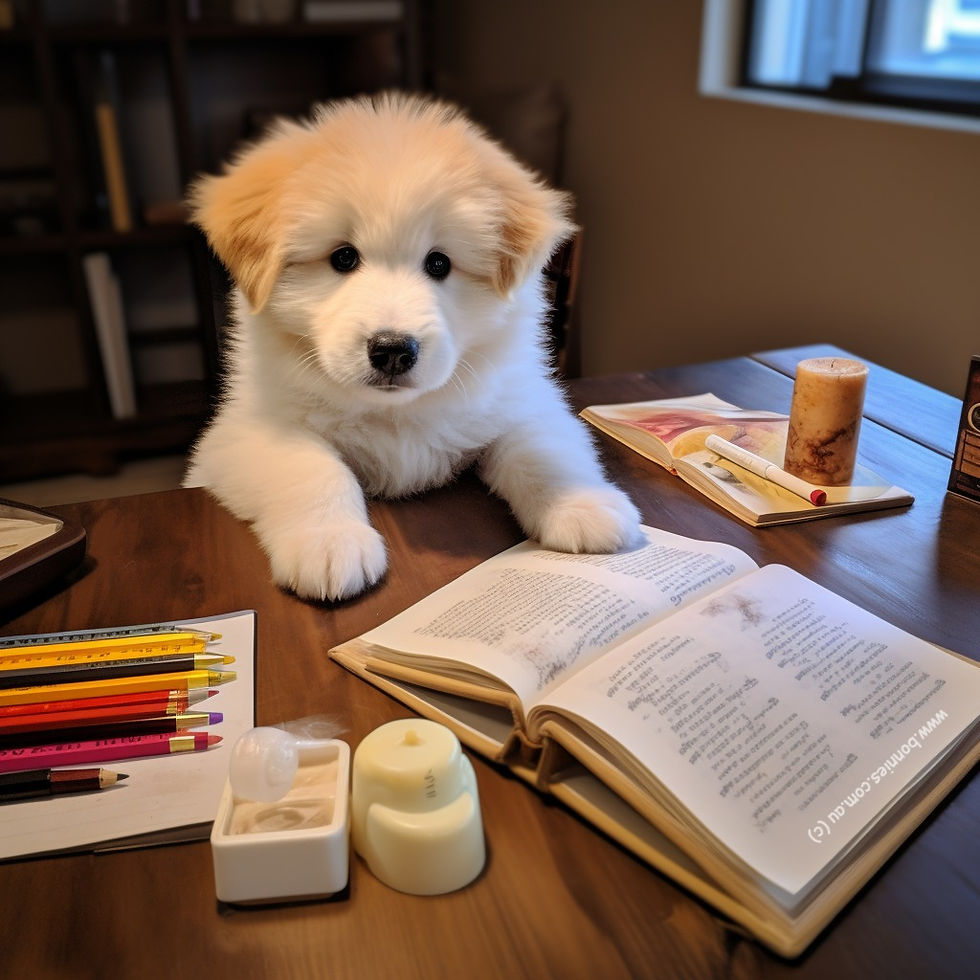Home Manners for Puppies: A Quick Guide to Good Puppy Etiquette
- Peter Bonney Director
- Jul 19, 2023
- 5 min read
Updated: Aug 23, 2023
Title: Home Manners for Puppies: A Quick Guide to Good Puppy Etiquette
Introduction: Welcoming a new puppy into your home is an exciting time, but it's essential to establish good manners from the start. By teaching your puppy proper behavior and setting boundaries, you'll create a harmonious environment for both your family and your future Best Mate. This blog post written by Peter Bonney will provide you with essential do's and don'ts, as well as priorities to consider when training your puppy.
What are the Home Manners for Puppies: A Quick Guide to Good Puppy Etiquette?
No Jumping Up On People.

Jumping might seem cute when your pup is small, but as they grow, this can become a safety concern, especially around children or elderly family members. Train your puppy to greet people politely with all four paws on the ground. Use rewards and consistent commands like "Off" or "Down" or "Leave" to reinforce this behavior. Generally if you are going to use the "Down" as a command when training the puppy to "Lie Down" then don't use it to get the puppy to not jump up. Clear, Concise, Calm communication works.
Keep the Licking to a Minimum
While some people find puppy licks adorable, excessive licking can become an annoyance and may even indicate anxiety or other behavioral issues. You can use distraction techniques, like giving them a toy, or simply saying "Leave" in a firm voice to curtail this behavior. We always use the word "Leave" when we are giving a verbal cue to our puppy to Stop. This command "Leave" should be used in conjunction with a "Stop" Hand signal as in the image above.
No Hyperactivity in the House
Puppies have a lot of energy, but allowing them to sprint around the house like a tornado isn't a good idea. Often, puppies are allowed to chase the children. This is a real no no. This could lead to broken items or accidents. Make sure to provide plenty of exercise and mental stimulation outdoors so that they are calmer when inside. Provide them with their OWN safe place. This is a KEY to a balanced home.
Quiet, Please! No Excessive Barking
A barking puppy can be quite disruptive, and it's essential to teach your fur baby when it's appropriate to bark and when it's not. Use positive reinforcement techniques, such as treats or praises, to reward quiet behavior. Identify triggers that cause excessive barking and try to eliminate them.
Indoor Toileting is a No-Go
Housebreaking is one of the first things you'll want to address with your new puppy. Create a consistent schedule and use puppy pads, if needed, to make it clear that going to the bathroom inside the house is off-limits.. This is ONLY if needed. We don't generally recommend them to our clients, however there are times where this may be necessary.
Patience at Meal Times
It might be tempting for your puppy to dive right into their food bowl, but teaching them to sit and wait for your signal before eating can instill good manners and self-control. Use the "Sit" and "Wait" commands consistently before putting down their food bowl.
Establish Boundaries, Especially for Kids' Rooms
It's important for puppies to know they don't have free rein over every inch of the house, particularly children's rooms where they might find things to chew on. You can use baby gates or closed doors to restrict access and train your puppy to respect these boundaries. These rules should not change. As I always suggest this is about restricting a puppy, so they can LEARN the rules of the HOUSE.
What are the Do's and Don'ts for home manners for Puppies?
Do's for Puppy Manners:
Make rules - Write them down - Put them on the fridge. We suggest this for all families with young kids.

Be consistent with those rules and commands to avoid confusion. Remember these rules may be for life for both family and puppy.
Socialise your puppy with different people, animals, and environments for confidence. - Read the Socialising your puppy blog.
Use positive reinforcement like treats and praise, tone and pitch for desired behaviors.
Set up and use a crate and a playpen to manage the puppy while it is very young. Val Bonney used playpens for some new puppies until they were 6 months of age. This consistency allowed Val to train her dogs up to Australian Champion status. They must live in a human world - teach them with love and respect.
Teach basic commands (sit, stay, come, leave it) for good manners and safety.
Train your puppy to greet people politely without jumping on or overly engaging guests. We recommend using the foot on leash control method - see Blog.
Don'ts for Puppy Manners:
Avoid using harsh punishments; opt for positive reinforcement instead. Please don't yell at your puppy and lashing out at them. This is certainly not fair on an animal who has been around 2 or 3 months.
Discourage rough play, biting, going crazy during the zoomies.
Don't feed from the table; teach your puppy to have their own designated spot during meals.
Don't let your puppy bite and nip family members or guests - Read the blog on Bing and mouthing.
Don't let your puppy jump up on people.
Don't let your little kids over engage your new puppy - when the puppy is in their Crate, Playpen or other designated area the kids are not allowed to interact or engage the puppy. Essential to ensure the puppy sees the kids as an alpha not another puppy. If they want to engage then bring the puppy out of THEIR space and into the house generally. On leash at first to show the puppy how to behave.
Avoid using pee mats after your puppy has learned to control their bladder at around 14 weeks. It's ok to have one in their playpen when your out, but please take it out when you get home. Yes, that does mean that you need to think about them, and take them to the toilet as necessary.
Don't let people come in/up to your puppy directly. It's always better to take your puppy out to meet them. On leash and under control until they learn how you want them to behave.
Training Priorities:
Prioritise house training using a crate and playpen - Read the blog on Crates and Playpens
Have designated bathroom areas - read the blog on Toilet Training.
Teach bite inhibition to avoid accidental injuries during play. - use the 'Leave or Leave It' command.
Leash train your puppy for calm walks using positive reinforcement.
Help your puppy develop independence by gradually increasing alone time in their crate or playpen to reduce separation anxiety. If you don't use these things then you should be separating your puppy in a room or other area of the house. - Read the blog on Separation Anxiety
Conclusion: When it comes to teaching good manners to your puppy, clear, concise, calm, consistent and controlled communication mixed with positive reinforcement, and established boundaries, are essential. Remember to prioritise house training, bite inhibition, leash training, and alone time. By investing time and effort into your puppy's training regimen, you'll set them up for a lifetime of good behavior, ensuring a happy and well-mannered member of the family.

For those residing in Brisbane, Australia, Peter Bonney, a renowned master puppy trainer, recommends taking advantage of the "4 Training Steps to a Successful Dog" offered by Bonnies:
Step 1 - Puppy Magic: Designed for puppies up to 18 weeks old.
Step 2 - Best Mates: Focused on basic dog training and obedience for dogs older than 16 weeks.
Step 3 - Unleashed: Suitable for all breeds with good basic obedience skills.
Step 4 - Limitless: Weekly classes on Saturdays, without the need for prior booking.
When seeking "dog training" or "Puppy training" in Brisbane, it is essential to be cautious of self-proclaimed "experts." One should inquire about their actual experience and credentials. Owning a dog for a few years does not automatically make someone a qualified dog trainer. Instead of searching generically for "Dog Trainer Brisbane," consider looking for Bonnies, a reputable option for dog training. To find more information about their services, you can visit their website at www.bonnies.com.au. Additionally, you may explore Val Bonney's best-selling books on dogs, available for purchase.





Great read. Thanks
I enjoyed the short read.
Now I can show the kids what we need to be doing. Great.